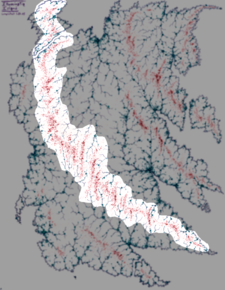Transilluminatian Range
Transilluminatian Range
Points of interest: Hammerstein, Nocturne, Verdi, Mystic Pass
The Transilluminatian Range is Illuminatia's largest and most significant mountain range, stretching the entire length of the continent, from its most northerly to most southeasternly extents. The Transilluminatian Range contains Illuminatia's tallest and most prominent mountain peaks. The mountain range extends beyond the confines of the mainland of Illuminatia, with detached portions of the range occupying Illuminatia's Baroque Isle, accounting for the range's northernmost extent. The southeasternmost portion of the range occupies Illuminatia's Modal Peninsula.
The Transilluminatian Range extends primarily in a north-to-south orientation through the range's northern half, and then takes on a northwest-to-southeast orientation in its southern half. Occupying land area generally within western and southeastern Illuminatia, the Transilluminatian Range bisects the continent into a smaller western region that accounts for roughly a third of the continent's land mass, and a more significant easterly region.
The mountain range follows a tectonically logical path in relation to other geographic features on the continent, with some of Illuminatia's coasts—namely the majority of the western coast and the southern shore of Randall Bay—paralleling the Transilluminatian' Range's course, in addition to the unanimity of Illuminatia's remaining mountain ranges roughly mirroring the Transilluminatian Range's orientation and shape.
While the Transilluminatian Range is Illuminatia's longest mountain range, it is also the continent's widest, occupying a width comparing to roughly one-sixth of the continent's length at the range's widest point. The Transilluminatian Range posed a significant barrier to land-based expeditionary efforts early in Illuminatia's history, with the mountain range's rugged topography and significant girth effectively splitting the continent into two unequal halves and isolating western coast settlements such as Rhapsody and Requiem from the rest of the continent. To this day, the West Coast Megalopolitan Complex and Southwestern Megalopolitan Complex to the west of the mountain range maintain particular cultural differences that contrast these regions' populations from that of the Randall Bay Megalopolitan Complex and Brookeview Ludwig Megalopolitan Complex to the east of the mountain range—largely thanks to the barrier to trade and cultural exchange that the Transilluminatian Range provided.
The most popular land-based route across the Transilluminatian Range is the Mystic Pass, the largest discontinuity in the mountain range. Located approximately midway through the range's span, the Mystic Pass provides the most significant route for traversing the range and became the major land-based route connecting the cities of Adamopolis with Rhapsody shortly after human settlement. The River Mystic originates within the Mystic Pass, flowing southward from the pass and emptying into the Philharmonic Bay. The River Mystic provides a major nautical transportation route from Mystic Pass. The city of Hammerstein, located on the shore of the River Mystic on the southwestern slope of the Transilluminatian Range, was established as a waypoint for travelers utilizing the Mystic Pass.
In northwestern Illuminatia, the major coastal cities of Nocturne and Vivaldi on Baroque Isle and the city of Verdi on the mainland occupy undulating land adjacent to the Transilluminatian Range, providing the scenic and recreational benefits of coastal and mountain life for their residents. In southeastern Illuminatia, the city of Melody is another coastal city located in a valley adjacent to the Transilluminatian Range.
In modern day Illuminatia, the Transilluminatian Range provides a convenient landmark for delineating organizational divisions based on geography. It also so happens that the first and third multiversal duplications of Lucidus survivors almost exclusively landed to the east of the range, while the second multiversal duplication populated the region west of the Transilluminatian Range—a further contribution to noted cultural differences that developed on either side of the range.
